SC Rewind: The 1967 Messenger
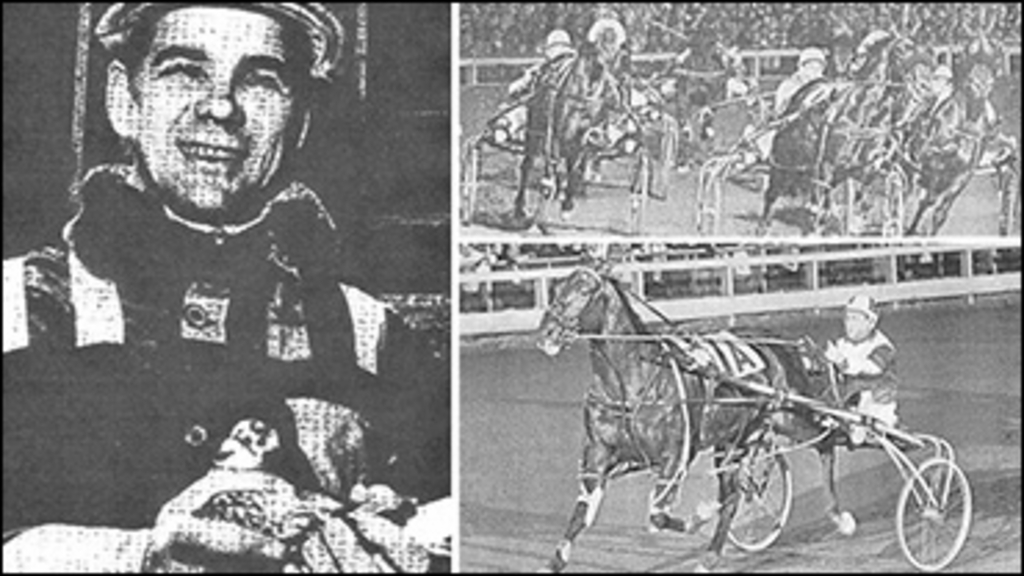
In the current edition of Rewind, Robert Smith recalls the famous Messenger Stake from 1967 and the rather unique way that the post positions were drawn for that year's event. He also takes note of the tremendous job done by the Publicity departments of racetracks in years gone by.
When the 1967 edition of the Messenger Stakes for three-year-old pacers was announced it had the distinction of being the richest event in harness racing history to that point in time. The purse offered for the 12th edition to be raced at Roosevelt Raceway on Long Island, New York on May 13th, was a whopping $178,064. Translated into 2020 dollars that would be about $1,346,000 taking inflation into account. To put it mildly it was a pretty "tidy sum" as the old saying goes.
With the record purse being offered and the status and prestige of the race itself, little more promotion and hype may have been needed. However, that was not the way things were done back then. Publicity departments at major Raceways back in the day never took a rest from going all out in their promotional activities. Another fan in the stands, one more new follower of harness racing was always the goal.
The publicity people seemed to always have a new trick up their sleeve but this one was a cut above most others. Most people in harness racing had long been accustomed to how the draw for post positions took place. A small group of people, perhaps two or three most times, huddled in the race secretary's office and went through the time-honoured process. A horse's name was read, numbered "peas" were drawn from a container and the digit (usually 1 thru 8 or however many entrants there were) was assigned to that horse. This procedure was repeated until the full card was assembled.
While that was the usual routine, something very different was in the offing for this year's Messenger. Here is how it wen: the Roosevelt publicity staff decided that because of the word "Messenger" that homing pigeons, who could be certainly described as messengers, would play a major role in this year's post position draw.
The day started at Locust Valley, Long Island right near the gravesite of the famous horse named Messenger, the namesake of this race. The draw was presided over by Charles Plumb of the New York State Harness Racing Commission. Once the draw was completed eight pieces of paper, each bearing the name of an entrant and their post position were wrapped around the legs of the birds. The site of the draw was some 10.5 miles away from the raceway by car, but only 7.3 miles by the way the pigeons flew. At 10:17 a.m. the birds were sent on their way to Roosevelt.
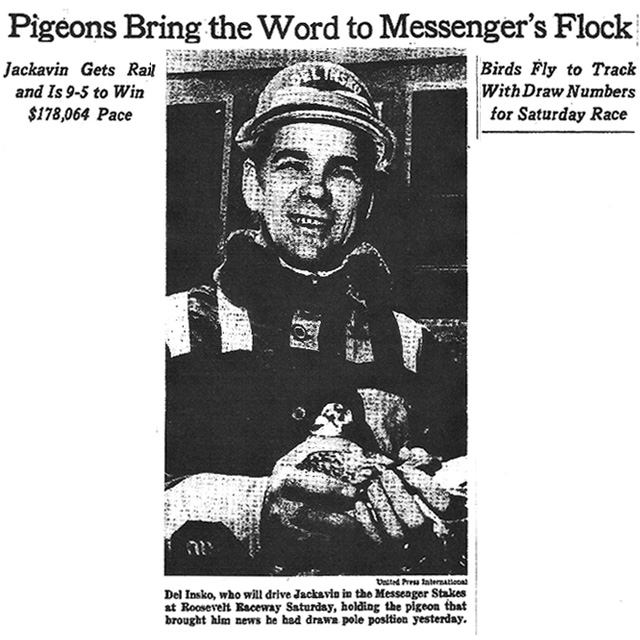
Horseman Del Insko holding the pigeon that brought him the news that he had drawn the pole position for the 1967 Messenger Stake (N.Y. Times)
The pigeons had been trained by a gentleman named Charles Biencasa, a pet shop operator from Rockville Centre, Long Island. Another gent from Long Island (who had no affiliation with harness racing) supervised the promotion. The pigeons were purchased from the Long Island Combine of Racing Pigeons, an organization of some 350 members. Following this assignment they were returned as a gift to the combine and were to be retrained for racing purposes. The two fellows who supervised the promotion explained that the pigeons could eventually fly 60 to 70 miles an hour. They also said that the birds might get lost but eventually would eventually find their way back to the cote.
The birds, each carrying a pacer's name and P.P. number, completed their assignment in one hour and 32 minutes. The story didn't specify if the birds all arrived at the same time but I can only assume that they did within a reasonable time as no word of search parties being sent out was mentioned. The coveted rail position went to a horse named Jackavin who was to be driven by Del Insko, a top driver of the day. The inexperienced son of Tar Heel was installed as the pre-race 9-to-5 favourite by oddsmaker Jack E. Lee. Insko was delighted by the draw but was quick to say "He should be rated no higher than third choice" behind the Haughton Stable entry and another top horse Best Of All.
Did the whole promotion attract any attention? I think the answer was a resounding YES! More than 50 reporters from newspapers, magazines, television and radio as well as a journalism class on field study from Long Island University awaited the arrival of the pigeons. In 1966, the draw for this race was flashed by the use of electronic dots and dashes from atop the Empire State Building. I wonder what they did in the years that followed?
The following is a list of horses from the 1967 Messenger Stakes and the post positions they drew via the homing pigeons. Also shown is the order of finish of the race.
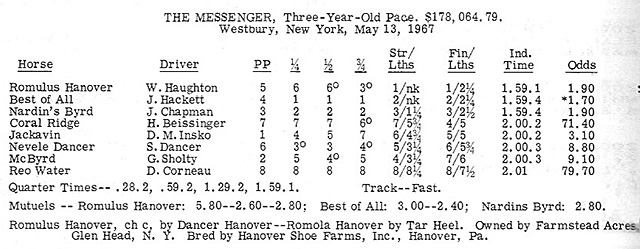
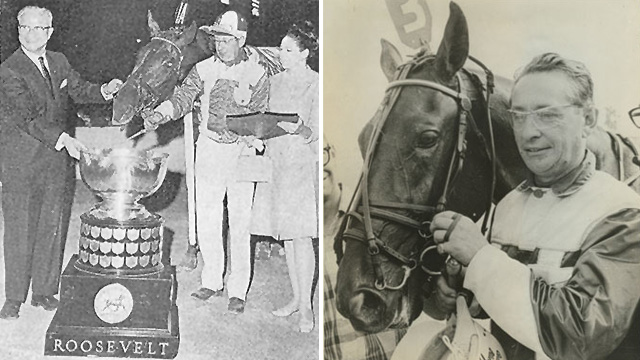
Left: Mrs. Robert Glasser, wife of the New York State Harness Racing Commissioner, and Alvin L. Weil, President of Roosevelt Raceway, present the Messenger Cup to Bill Haughton following Romulus Hanover's win. (Roosevelt) Right: Romulus Hanover and Bill Haughton after a win in Quebec
Quote For The Week: "When I leave the track after the races are over I don't want to say 'I'm even' ; that's what I was when I got here." These were the words of the legendary Jimmy Grover of Glencoe, Ont. a man who loved to go to the races and loved to BET I hope someone in the reading audience remembers him as I do.
Who Is It?
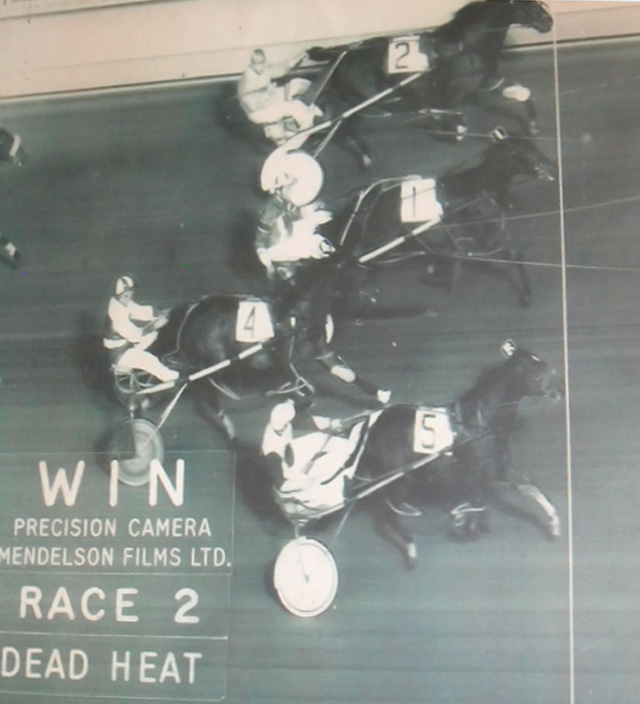
A few weeks ago a picture of Canada's first ever triple dead heat for win which happened at Windsor Raceway in 1970 was displayed. It was a shot of the finish but not a photo finish. Shown above is the official photo finish showing the three winning horses hitting the wire simultaneously with the fourth place finisher being #4. The question is, who was the driver of that #4 horse? If you're really sharp, give us the horse's name if you can.
Who Else Is It?
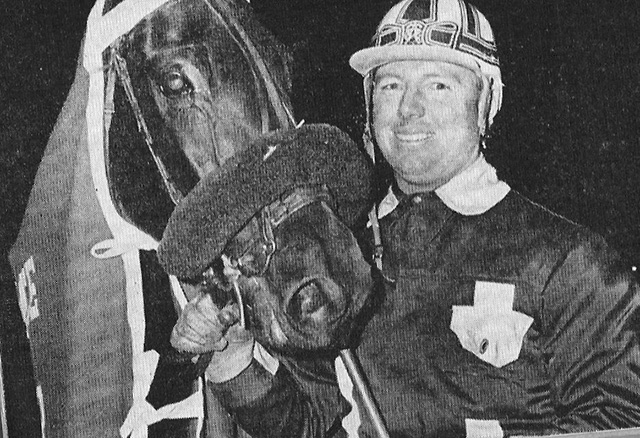
This young man was a popular U.S. driver who on occasion brought a horse to Canadian track to compete, usually a Grand Circuit or stakes performer from his top stable. This photo was taken over 50 years ago but he is still with us. Can you name him? (Hoof Beats photo)
Stay tuned during the upcoming week as our "experts" solve the mystery photos. The correct answers will be given.


This week's pictures were
This week's pictures were again solved with relative ease. In the Windsor triple dead heat photo the #4 horse was Mary Kent driven by Gregory Wright. In the lower picture was 24-year-old John Simpson Jr. and while not part of the quiz he was shown with two-year-old Berlinda Hanover at Yonkers Raceway in 1967. Many years ago I was privileged to meet both John Jr. and his father John Sr. at their winter training location north of Orlando, Florida. I was introduced by the great Delvin Miller. Imagine; I was in a room with three people who had each won the Hambletonian!
Mystery photo John Simpson
Mystery photo John Simpson Jr.
#4 Greg Wright and Mary Kent
#4 Greg Wright and Mary Kent
mystery photo: John Simpson
mystery photo: John Simpson Jr
The second photo looks like
The second photo looks like John Simpson Jr. Regards, Bert Clish
Looks like John Simpson Jr.
Looks like John Simpson Jr.
#4 Greg Wright driver.
#4 Greg Wright driver.
I do know it's Greg Wright
I do know it's Greg Wright finishing 4th. Bottom John Simpson jr.